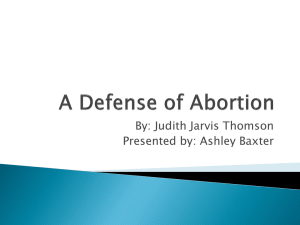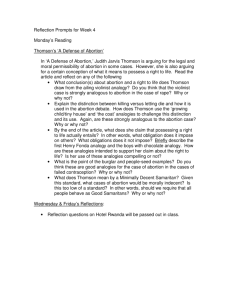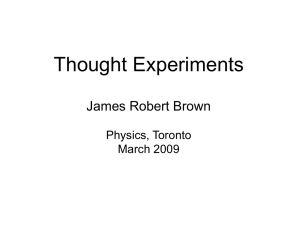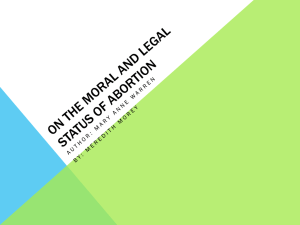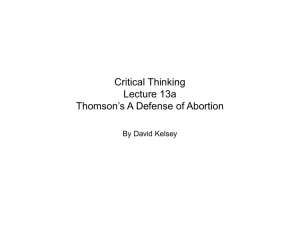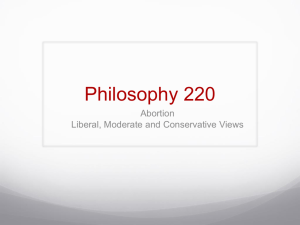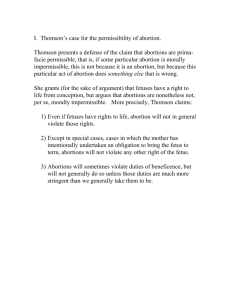An Analysis on the Utilization of Thought Experiments
advertisement
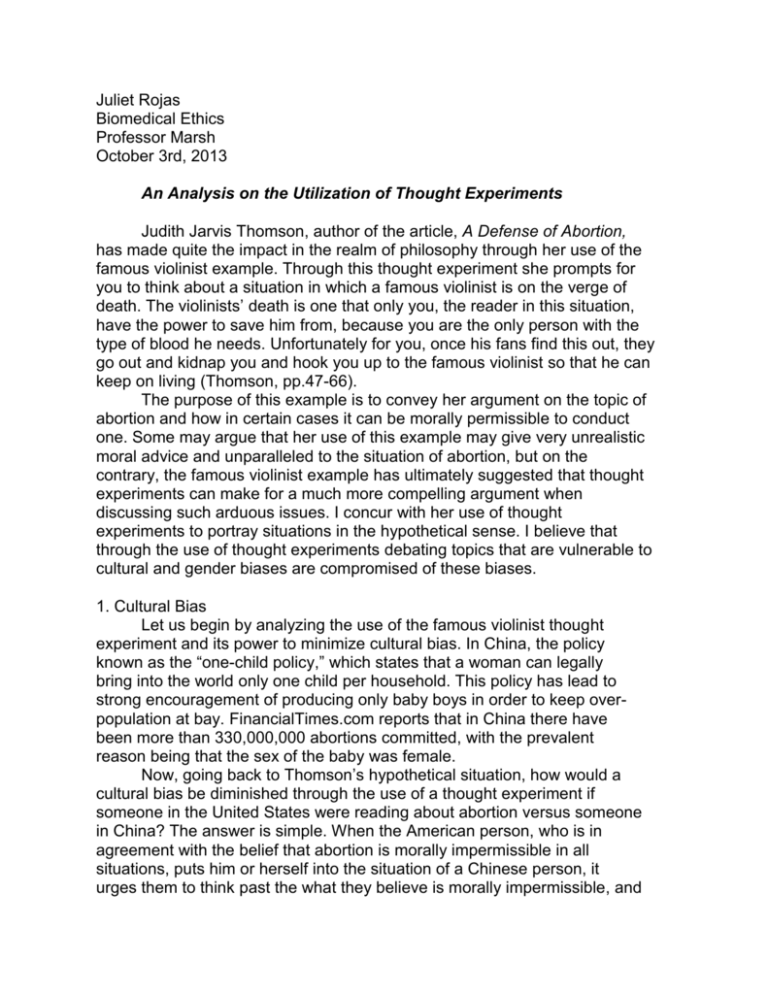
Juliet Rojas Biomedical Ethics Professor Marsh October 3rd, 2013 An Analysis on the Utilization of Thought Experiments Judith Jarvis Thomson, author of the article, A Defense of Abortion, has made quite the impact in the realm of philosophy through her use of the famous violinist example. Through this thought experiment she prompts for you to think about a situation in which a famous violinist is on the verge of death. The violinists’ death is one that only you, the reader in this situation, have the power to save him from, because you are the only person with the type of blood he needs. Unfortunately for you, once his fans find this out, they go out and kidnap you and hook you up to the famous violinist so that he can keep on living (Thomson, pp.47-66). The purpose of this example is to convey her argument on the topic of abortion and how in certain cases it can be morally permissible to conduct one. Some may argue that her use of this example may give very unrealistic moral advice and unparalleled to the situation of abortion, but on the contrary, the famous violinist example has ultimately suggested that thought experiments can make for a much more compelling argument when discussing such arduous issues. I concur with her use of thought experiments to portray situations in the hypothetical sense. I believe that through the use of thought experiments debating topics that are vulnerable to cultural and gender biases are compromised of these biases. 1. Cultural Bias Let us begin by analyzing the use of the famous violinist thought experiment and its power to minimize cultural bias. In China, the policy known as the “one-child policy,” which states that a woman can legally bring into the world only one child per household. This policy has lead to strong encouragement of producing only baby boys in order to keep overpopulation at bay. FinancialTimes.com reports that in China there have been more than 330,000,000 abortions committed, with the prevalent reason being that the sex of the baby was female. Now, going back to Thomson’s hypothetical situation, how would a cultural bias be diminished through the use of a thought experiment if someone in the United States were reading about abortion versus someone in China? The answer is simple. When the American person, who is in agreement with the belief that abortion is morally impermissible in all situations, puts him or herself into the situation of a Chinese person, it urges them to think past the what they believe is morally impermissible, and rather in the context of the culture in which the situation is taking place. For the person in China who believes it is wrong to have a child if it is not a boy will have to, similarly to the American person, take into consideration the culture in which the situation is taking place. The violinist example promotes the reader to contextualize the abortion decision’s cultural imperative, which enables for the determination of its moral permissibility in a non-confounding manner. 2. Gender Pre-disposition In addition to thought experiments minimizing cultural biases in arguments such as abortion, they are also useful in reducing the effect of the gender predisposition. For the most part, a male would feel less compelled to consider himself pregnant because it is biologically unnatural for men to become pregnant. Conveniently, thought experiments such as the violinist example enable for a biological indifference to the situation. Through the thought experiment, our male participant is interactive within the abortion debate because his life is at stake. He is now held accountable for choosing whether or not he wants to continue helping the violinist live. This no longer entails having to think about actually carrying a baby in your womb for 9 months, but more so thinking about what it would be like if the situation affected you directly. 3. Unrealistic Moral Advice For those who believe that thought experiments are irrelevant to the actual importance of the situation in its innate context, it is plausible see how they may interpret the hypothetical situations to be lending unrealistic moral advice. The metaphorical examples that are used in thought experiments are subtly related to the situations in which they allude to such that they may be perceived as having no moral imperative by those who are not prone to facing the moral dilemma caused by the situation. However, the purpose of thought experiments is to exemplify the situation in such a manner that innate biases caused by biological and demographic traits do not affect one’s evaluation of whether or not the situation is morally permissible. In summary, I strongly support the use of thought experiments since they are beneficial to conceptualizing moral dilemmas in a way that minimizes biases. As we have examined, they are especially useful in dilemmas where cultural and gender predispositions are exist, because they allow for a broader evaluation of the situation altogether, rather than the topic alone. References Judith Jarvis Thomson, “ A Defense of Abortion.” pp.47-66 from Philosophy and Public Affairs 1: 1 (1971). © FinancialTimes.com < http://www.ft.com/intl/cms/s/2/6724580a-8d64-11e282d2-00144feabdc0.html#axzz2gj0zAiAW>
